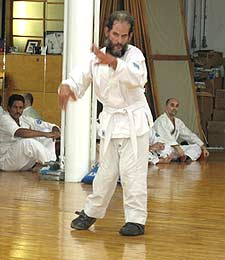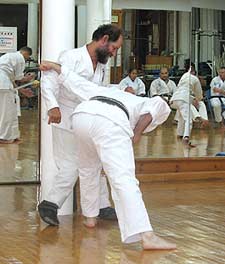A Spirit That Inspires - The Story Of Kevin, Continued
By Christopher Caile
 |
Kevin Fabiny |
Last weekend I was thrilled to see and house in NYC a former student
of mine from Buffalo, NY who was asked to test for his second-degree black
belt in karate.
His name is Kevin Fabiny. He is very different from other karate students,
because since birth he has been severely limited physically.
Born with cerebral palsy, he was for most of his life pretty much limited
to a wheel chair. For this reason he was never allowed to participate
in sports.
This all changed almost 21 years ago when I was teaching Seido Karate
at the State University of New York at Buffalo (SUNY). One evening before
class as people were warming up, a bearded man in a wheel chair (he was
a student there at this time) came to the edge of the mat and said something.
I had no idea what he said.
Again he spoke in very blurred speech, “Caan Iiii Stuuudy Karrratttee?”
This time I understood him, and after thinking for a moment I said “yes,”
but that I wouldn’t make special accommodations for him. If he fell
down, he would have to get up himself.
 |
Kevin performing kata during his
test |
Kevin looked back somewhat surprised. Although his speech was difficult
to understand, he said that he had asked various sports organizations
and clubs for years if he could participate, but the answer had always
been “NO.”
I was teaching Seido Karate (a club program) which was founded by Kaicho
Tadashi Nakamura who had left a senior position as a member of a very
hard, full contact style of karate (Kyokushin). His great insight on founding
Seido was that karate and its philosophy could benefit everyone, not just
the young, strong and those who wanted to specialize in hard fighting.
Kevin is an example of this challenge. Over the years I watched Kevin
get stronger, and his growing ability to escape the wheelchair, to walk
better without assistance, to climb stairs and to fend for himself. His
movements improved, although he was always limited by poor coordination,
muscle control, balance and strength.
 |
Kevin with a partner demonstrates
a self-defense technique. |
But stubbornly Kevin came to class. When I was teaching Kevin had to
use his motorized wheelchair to get to the subway and take it to one campus,
then take a campus special handicapped vehicle between campuses, then
get himself to the training facility and then at the end of class do the
reverse to get home. There were even times when he came to class without
his wheel chair, but this required extra effort to walk to the subway
and ride a regular bus between campuses. I understand that he continues
this two hour each way ritual even today.
He would always arrive an hour or two before class so he could do his
own kind of physical therapy—climbing stairs, walking around the
running track, doing modified push-ups, etc. and then participate in class.
He eventually achieved his black belt. (See “The
Story About Kevin”).
|
Kevin participating in free fighting,
with the author, Sei Shihan Christopher Caile supervising (background).
Over the course of an hour Kevin fought four or five opponents.
While he is able to punch and block, Kevin has very limited kicking
ability due to his physical limitations. |
Over time I began to realize the Kevin was also fighting for his life.
He once told me that people with his condition often deteriorated physically
which could lead to premature death. Thus his work ethic, his karate participation,
was staving off physical deterioration.
In Seido we have a saying, “Technique rather than strength and
spirit rather than technique.” And while Kevin was limited in the
first two, he remains inspirational in his spirit. In this way he taught
me a lot.
After I left Buffalo more than ten years ago, Kevin continued under Sensei
Jeff Evenson and then Senpai Peter Macaluso when he took over the program.
Kevin is now the senior student. He has been like the “Energizer
Bunny.” He keeps coming to class, and keeps practicing. This year
he was asked to test for his second-degree black belt.
When I saw Kevin again I realized that this test would even be harder
for him. Despite all his efforts, exercise and practice, he has lost some
muscle strength and his balance has deteriorated a bit. Kevin told me
that previously when he fell down, he could usually get up in place, but
now he had to crawl to a wall or pillar and use that to help himself get
upright.
|
Kevin being awarded his second-degree
black belt by Kaicho Tadashi Nakamura. |
His eyesight has also become more limited too. Never great, over the
last few years he has totally lost sight in one eye.
I think he is probably afraid for his future, although he doesn’t
show it. One of the students who accompanied him from Buffalo said that
Kevin told him where he wanted to be buried and how. But this last week
I never saw any cloud over his thoughts. When I asked him about his comments
to the other student, he told me of his father who was now 86 years old
and that he has good genes.
And in all the time I have known him, Kevin has never been bitter, or
shown a negative attitude or anger toward his condition. Instead, he has
always been upbeat, and quick with the joke or insightful comment.
During his two-day test Kevin fully participated – he didn’t
want special treatment. He free fought, demonstrated kata and self-defense
drills and two man exercises with others taking their tests.
|
Kaicho Nakamura and Sei Shihans
William Best and Mike Reeves congratulating Kevin after his promotion. |
At this point you might be asking yourself, “How could a man so
physically limited ever qualify for a black belt, much less a second degree
black belt?” The answer is simple.
Belts in martial arts don’t just signify strength or fighting ability
(that’s why in most pure sports there are no ranks or belts). They
also signify personal development, discipline and spirit. That’s
also why there are junior belts. Those under 16 (sometimes 15) aren’t
considered to have developed mentally to the point that they can exhibit
a developed sense of morality, internal direction, dedication to practice
and outward exhibition of etiquette necessity for award of a full black
belt. Thus junior belts are considered incomplete, usually with a white
or other color stripe down the middle.
Kevin in his test over two days showed everyone something rare –
limited ability totally over shadowed by spirit, of stick-to-it-ness,
self-discipline and strength of commitment. It was inspirational.
At the conclusion of testing, participants were awarded their belts.
Kaicho Nakamura asked me to introduce Kevin and give some background on
him and his studies. I recounted his history, his challenges, his work
ethic as well as his keen sense of humor, his insightful knowledge. I
also noted that the one time he had been attacked, he had nearly beaten
up his assailant before other intervened.
I told the other students that whenever I feel tired, or had a small
injury, and thought about missing practice, I think of Kevin who has to
try so much to do anything. I remember Kevin falling down, again and again
and again and getting himself up – literally thousand of times.
His continued practice illustrates the principle “strength of spirit
over flesh, of discipline over weakness, and of mind over body.”
There was thunderous applause, and more than a few tears were seen on
the faces of others.
I want to thank Kevin for showing me his way, his spirit and dedication
and as such he has become one of my teachers. And if in Buffalo on the
street or at the University of Buffalo you see a partially bald and bush
bearded man in a wheel chair, pay him some respect. If it is Kevin, he
has earned it.
About The Author:
Christopher Caile is the Founder and Editor-In-Chief of
FightingArts.com. He has been a student of the martial arts for over 50
years and a teacher of karate since 1962. He is the author of over 300
articles and columns on the martial arts and editor of several martial
arts books. Over the last 20 years he has conducts seminars on street
self-defense to community and student groups in both the United States
and Canada. His seminars topics also include his specialty areas of kata
applications and joint locks and other jujutsu-like techniques found within
karate. Caile started his martial arts career in judo. Then he added karate
as a student of Phil Koeppel in 1959. Caile introduced karate to Finland
in 1960 and then hitch-hiked eastward. In Japan (1961) he studied under
Mas Oyama and later in the US became a Kyokushinkai Branch Chief. In 1976
he followed Kaicho Tadashi Nakamura when he formed Seido karate and is
now a 6th degree black belt (Sei Shihan) in that organization's honbu
dojo (NYC). He is also Sensei in Wadokai Aikido under Roy Suenaka Sensei.
Other experience includes diato-ryu aikijujutsu, Hakuho-Ryu Aiki-jujutsu,
kenjutsu, kobudo, Shinto Muso-ryu jodo, kobudo, boxing and several Chinese
fighting arts including Praying Mantis, Pak Mei (White Eyebrow), Wing
Chun, Chin Na and Shuai Chiao. He is also a student of Zen. A long-term
student of one branch of Traditional Chinese Medicine, Qigong, he is a
personal disciple of the qi gong master and teacher of acupuncture Dr.
Zaiwen Shen (M.D., Ph.D.). He holds an M.A. in International Relations
from American University in Washington D.C. and has traveled extensively
through South and Southeast Asia. He frequently returns to Japan and Okinawa
to continue his studies in the martial arts, their history and tradition.
In his professional life he has been a businessman, newspaper journalist,
inventor and entrepreneur.
|